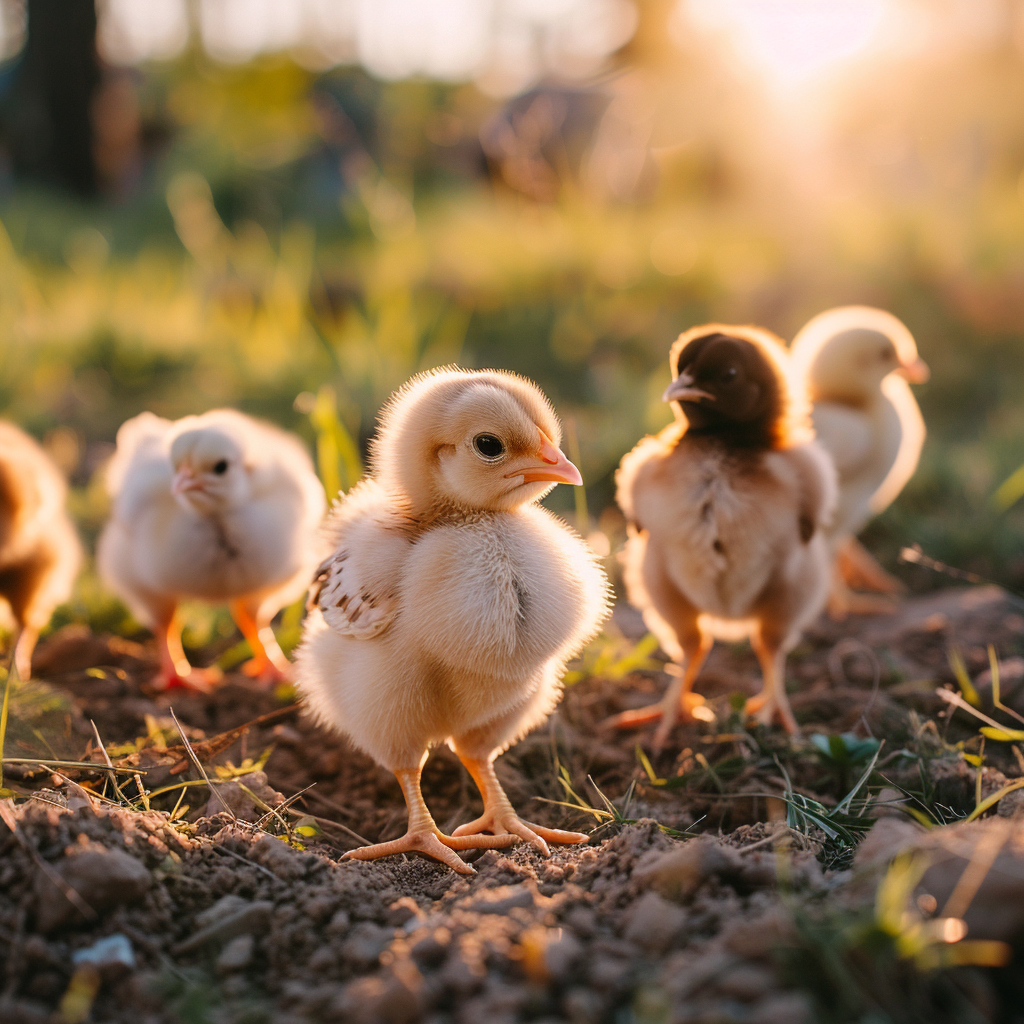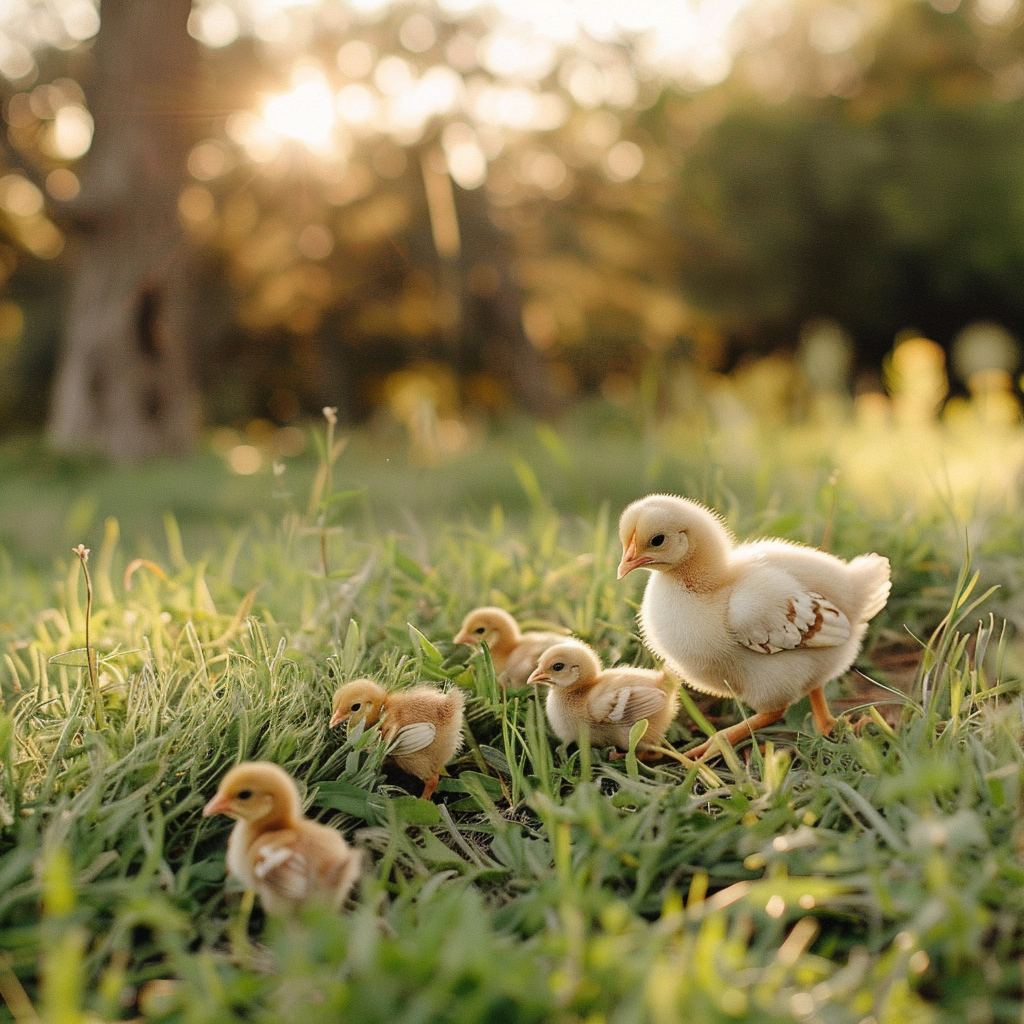Introduction
When can chicks go outside? This is a vital question for anyone raising baby chicks, as knowing the right time ensures their safety and well-being. Transitioning chicks outdoors too early can expose them to risks like cold temperatures and predators. Key factors that influence this decision include the chicks’ age, feathering, and the prevailing weather conditions. Understanding these aspects helps in creating an optimal environment for the chicks’ growth and development.
What You’ll Need for Safely Moving Chicks Outside
Ensuring a smooth transition for your chicks from indoor to outdoor living requires careful preparation and the right equipment. Here’s what you’ll need:
Heat Source: Initially, a heat lamp or radiant heater is essential to keep the chicks warm, especially during cooler nights or sudden weather changes.
Secure Outdoor Space: An enclosed area that protects the chicks from predators is crucial. This space should be secure and safe to prevent any potential threats.
Feeder and Waterer: Adequate feeding and hydration are vital for the chicks’ health. Ensure you have a reliable feeder and waterer to keep them nourished.
Acclimatization Plan: Gradual exposure to outdoor conditions helps the chicks adjust without stress. Develop a plan to increase their time outside progressively.
Heat Source
Providing a reliable heat source is the first step in preparing your chicks for the outdoors. A heat lamp or radiant heater will keep them warm and comfortable, reducing the risk of stress and illness. As they grow and develop more feathers, their need for supplemental heat decreases.
Secure Outdoor Space
Creating a safe and secure outdoor environment is paramount. Ensure the area is enclosed to protect the chicks from predators such as hawks, raccoons, and stray cats. The enclosure should be sturdy and predator-proof, offering peace of mind while your chicks explore their new surroundings.
Essential Ingredients for Healthy Chicks Outside

Providing the right ingredients and conditions is essential for raising healthy chicks. Here’s what you need:
Healthy Chicks: Ensure your chicks are in good health before transitioning them outdoors. Healthy chicks are better equipped to handle the change in environment.
Proper Nutrition: A balanced diet is crucial. Start with a high-quality starter feed, provide grit to aid digestion, and offer occasional treats to ensure a varied diet.
Vaccination: Consult with a vet to determine the necessary vaccinations. Proper vaccination helps build immunity and protect your chicks from diseases.
Healthy Chicks
Before moving chicks outside, make sure they are healthy. Monitor their behavior and look for signs of illness, such as lethargy, poor appetite, or abnormal droppings. Healthy chicks are more resilient and can adapt better to new environments.
Proper Nutrition
Nutrition plays a vital role in the growth and development of chicks. Start them on a high-protein starter feed, which is essential for their growth. Introduce grit to aid their digestion, and occasionally provide fresh fruits and vegetables as treats. Remember, treats should make up no more than 10% of their diet to ensure they receive balanced nutrition.
Instructions for Transitioning Chicks Outside
Transitioning chicks to the outdoors requires a step-by-step approach to ensure their safety and well-being. Here’s how to do it:
Initial Acclimatization
Start bringing chicks outside for short, supervised sessions when they are about 3-4 weeks old. Ensure the temperature is suitable, ideally above 65°F during the day. This gradual exposure helps them get used to the new environment without the shock of sudden changes.
Start Slowly
Begin by allowing the chicks to explore the outdoor space for a few minutes each day, gradually increasing the time as they become more comfortable. Always supervise these sessions to ensure their safety and observe how they react to the new surroundings.
Temperature Considerations
Monitor the weather closely. If the temperature drops or becomes too windy, bring the chicks back inside to prevent them from becoming chilled. Using a thermometer can help you keep track of the temperature in the outdoor space.
Gradual Transition
Increase outdoor time gradually as chicks grow. When they are around 6 weeks old, you can move them to an unheated brooder to help them acclimate to ambient temperatures. This step prepares them for living outside without the constant warmth of a heat lamp.
Extend Outdoor Sessions
As the chicks grow and develop more feathers, they can spend longer periods outside. By the time they are 6 weeks old, they should be able to handle cooler temperatures during the day, but still, keep a close watch on their behavior and health.
Move to Unheated Brooder
At this stage, transition them to an unheated brooder during the day to help them get used to outdoor conditions. This practice toughens them up and reduces their dependence on artificial heat sources.
Permanent Move
Once chicks are fully feathered, usually at around 6-8 weeks old, and temperatures stay above 50°F at night, they can move outside permanently. Here’s how to ensure a smooth transition:
Check Feathering
Fully feathered chicks are better equipped to regulate their body temperature. Before moving them outside permanently, ensure they have all their feathers, especially on their wings and chest, which are crucial for warmth.
Prepare the Coop
Make sure the coop is predator-proof and weather-protected. It should be sturdy, with no gaps or holes that predators could exploit. Additionally, the coop should provide adequate shelter from rain, wind, and extreme temperatures.
Moving Day
Choose a day with mild weather for the permanent move. This reduces the stress on the chicks and makes the transition smoother. Place them in the coop in the late morning, giving them time to explore and settle in before nightfall.
Nighttime Temperatures
Ensure that nighttime temperatures remain stable and above 50°F. If there’s a sudden drop in temperature, be prepared to bring the chicks back inside or provide additional warmth in the coop.
Monitor Adjustment
In the first few days, check on the chicks frequently to ensure they are adjusting well. Look for signs of distress, such as huddling together excessively or not eating. Providing familiar items from their brooder, like the feeder and waterer, can help them feel more at home.
Predator Protection
Secure the coop every night to protect the chicks from nocturnal predators. Ensure that the coop door is closed and that there are no weak spots where predators can enter.
Nutrition Score: What Baby Chicks Need Outside
Proper nutrition is crucial for the healthy growth and development of chicks. Here’s what you need to focus on:
High Protein Feed: Chicks require a diet high in protein to support their rapid growth. A starter feed with 20-24% protein is ideal for the first few weeks.
Clean Water: Always provide clean, fresh water. Hydration is essential for digestion, temperature regulation, and overall health.
Treats in Moderation: While treats can be a fun addition, they should not exceed 10% of the chicks’ diet. Fresh fruits and vegetables are good options, but ensure they are safe for chicks and given in appropriate quantities.
High Protein Feed
The foundation of a chick’s diet should be a high-quality starter feed. This feed is specially formulated to meet their nutritional needs, with a high protein content to support growth. Continue feeding them starter feed until they are about 8 weeks old before transitioning to a grower feed.
Benefits of High Protein
High protein levels support muscle development and overall growth. It ensures the chicks develop strong bones and a healthy immune system. Additionally, it helps in the proper development of feathers.
Clean Water
Providing clean water is non-negotiable. Use a chick waterer to ensure the water stays clean and doesn’t get contaminated with bedding or droppings. Change the water daily and clean the waterer regularly to prevent the spread of disease.
Hydration Importance
Water is essential for digestion and nutrient absorption. Dehydration can lead to severe health issues, so always check that the chicks have access to fresh water. In hot weather, ensure the water is cool to encourage drinking.
Treats in Moderation
Treats should be given sparingly to avoid disrupting the nutritional balance. Suitable treats include small amounts of fruits, vegetables, and occasional grains. Avoid giving too many treats to ensure the chicks consume enough of their balanced starter feed.
Safe Treats
Introduce treats slowly and in small quantities. Good options include chopped greens, small pieces of apple, and cooked rice. Always ensure that the treats are safe for chicks and do not contain harmful substances.
Serving & Storage: Caring for Chicks Outdoors

Proper daily care and monitoring are essential for the well-being of your chicks once they move outdoors. Here’s what you need to focus on:
Daily Care: Regular feeding, watering, and cleaning of the coop are crucial. Ensure that the chicks have constant access to clean food and water.
Monitor Health: Watch for signs of illness or distress. Early detection of health issues can prevent serious problems and ensure the chicks remain healthy and active.
Daily Care
Maintaining a clean and hygienic environment is key to preventing diseases and promoting healthy growth. Clean the coop regularly, removing any soiled bedding and replacing it with fresh material. Ensure the feeder and waterer are always clean to prevent contamination.
Routine Feeding
Provide fresh feed daily and ensure the chicks consume their starter feed as the primary diet. Avoid letting the feed sit for too long to prevent it from becoming stale or contaminated. Monitor the amount of feed to ensure each chick is getting enough to eat.
Monitor Health
Regularly check the chicks for any signs of illness or distress. Common symptoms to watch for include lethargy, loss of appetite, unusual droppings, and respiratory issues. If any chicks appear unwell, isolate them and consult a veterinarian promptly.
Health Checks
Conduct routine health checks by gently handling the chicks and looking for any abnormalities. Check their feathers, eyes, beak, and legs for any signs of issues. Early intervention can make a significant difference in the health outcomes of your chicks.
Environmental Management
Keep the coop well-ventilated but free from drafts. Ensure it stays dry and is protected from extreme weather conditions. Provide adequate space for the chicks to move around comfortably, promoting healthy exercise and preventing overcrowding.
Temperature Regulation
Monitor the temperature inside the coop, especially during the night. While fully feathered chicks can handle cooler temperatures, it’s important to ensure they are not exposed to extreme cold. In colder climates, consider using a safe heating source or extra bedding for insulation.
Variations in Transitioning Chicks Outside
Different breeds and weather conditions can significantly affect how and when you transition chicks to the outdoors. Here’s what you need to consider:
Breeds: Various breeds of chicks have different cold tolerances and feathering times. Research your specific breed to understand its unique requirements.
Weather Conditions: Local climate conditions play a crucial role in determining when chicks can go outside. Adjust your plans based on the weather to ensure the chicks’ safety and comfort.
Breeds
Each breed of chicken has unique characteristics that influence its ability to adapt to outdoor conditions. Some breeds, like Silkies, may take longer to feather out fully and are more sensitive to cold. In contrast, hardy breeds like Rhode Island Reds or Plymouth Rocks may be ready to transition outside sooner.
Understanding Breed Differences
Knowing the specific needs of your breed helps in making informed decisions about when to start the transition. For example, lightweight breeds generally feather out faster than heavier breeds, impacting when they can handle cooler temperatures.
Weather Conditions
The local weather significantly impacts the safety and comfort of chicks when transitioning to the outdoors. In regions with milder climates, chicks may be able to move outside earlier. Conversely, in areas with unpredictable or harsh weather, you might need to wait longer and take extra precautions.
Seasonal Adjustments
Adjust your timing based on the season. In spring, gradual temperature increases make it easier for chicks to adapt. In contrast, if transitioning during fall, be mindful of dropping temperatures and the potential for sudden cold snaps.
Adapting to Local Climate
Monitor the weather forecasts regularly. On particularly cold or rainy days, consider delaying outdoor time or providing additional shelter and warmth. Create a backup plan for unexpected weather changes to ensure the chicks remain safe and comfortable.
Creating a Safe Outdoor Environment
In warmer climates, ensure the chicks have access to shade and plenty of water to prevent overheating. In colder climates, focus on wind protection and maintaining a dry environment to prevent chilling.
FAQs About Moving Chicks Outside
Here are some frequently asked questions about when chicks can go outside and how to ensure their safety during the transition:
What age can chicks go outside without heat?
Chicks can typically go outside without a heat source around 6 weeks old, provided they are fully feathered and temperatures are stable. This age can vary slightly depending on the breed and the weather conditions.
How long do baby chicks need a heat lamp?
Chicks need a heat lamp for about the first 6 weeks. Start with temperatures around 95°F and decrease by 5°F each week until they are fully feathered and can regulate their body temperature.
What happens if you put chicks outside too early?
Putting chicks outside too early can expose them to several risks:
- Hypothermia: Young chicks cannot regulate their body temperature well and may become chilled.
- Stress from Harsh Weather: Rain, wind, and sudden temperature changes can be stressful and harmful.
- Increased Predator Vulnerability: Without a secure enclosure, chicks are more exposed to predators.
- Socialization Issues: Early exposure to a new environment can affect their behavior and interaction with other chickens.
Can 4-week-old chicks be outside?
Yes, 4-week-old chicks can be outside for short, supervised periods if the weather is warm and calm. Ensure they have some feathering and bring them back inside if they show signs of distress.
Additional Considerations
When allowing younger chicks outside:
- Supervision: Always supervise them to ensure they do not wander off or get into dangerous situations.
- Gradual Acclimatization: Start with short sessions and gradually increase the time they spend outside as they get used to the new environment.
How to ensure a smooth transition?
To ensure a smooth transition:
- Start Slowly: Begin with short outdoor sessions and gradually increase the duration.
- Monitor Weather: Choose warm, calm days for outdoor time.
- Provide Protection: Use a secure, enclosed area to keep chicks safe from predators and harsh weather.
Conclusion
Transitioning chicks from the brooder to the great outdoors is a significant step in their development. Timing and preparation are crucial to ensure their safety and health. Here are the key points to remember:
When can chicks go outside? Typically, chicks can go outside permanently at 6-8 weeks old, once they are fully feathered and temperatures are stable above 50°F at night. However, this can vary based on the breed and local weather conditions.
Gradual Acclimatization: Start by exposing chicks to the outdoors for short periods at around 3-4 weeks old. Gradually increase their outdoor time as they grow and develop more feathers. Move them to an unheated brooder around 6 weeks to help them acclimate to ambient temperatures.
Preparation and Monitoring: Ensure the outdoor space is secure and predator-proof. Regularly check the chicks’ health and behavior during the transition. Providing proper nutrition, clean water, and a safe environment are vital for their growth.
Adjust for Variations: Different breeds and local weather conditions require adjustments in your plan. Research your specific breed and monitor the weather to make informed decisions.
